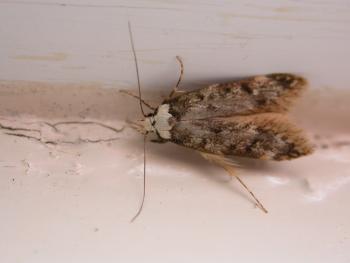
Endrosis
sarcitrella
(White Shouldered Moth)
(White Shouldered Moth)
This widely distributed insect feeds on a great variety of plant material, such as dry seeds, seed potatoes, rubbish in bird nests, thatch on roofs, fungi on trees, and miscellaneous dry vegetable refuse. It is known to do serious damage in wine cellars by boring into corks, and is also said to infest homes, feeding on dry seeds, meal, and carpets. In Great Britain, where the oecophorids appear to be more important pests of stored products than they are in the United States, Endrosis sarcitrella is almost certain to be found wherever broken grain, flour, or other vegetable debris is allowed to accumulate undisturbed. This species is widely distributed, and in a survey of insects on stored foods and seeds, it was recorded from corn and other grains, mixed feeds, and wheat branDescription: The male and female average 6.3 and 10.5 mm long, respectively. Recently emerged adults can be readily recognized by their white shoulders and prothorax, contrasting with the grayish-whiteforewings that are marked by dark patches. The hindwings are narrowed toward the tips, somewhat like those of the Angoumois grain moth (Sitotroga cerealella), but not so acutely.
Life Cycle: Egg incubation requires 10 to 58 days, the larval period is 38 to 133 days, and the period from egg to adult is 62 to 235 days. The full-grown larva is about 12 mm long, and white, with a brownish head, in fact very similar to the brown house moth.